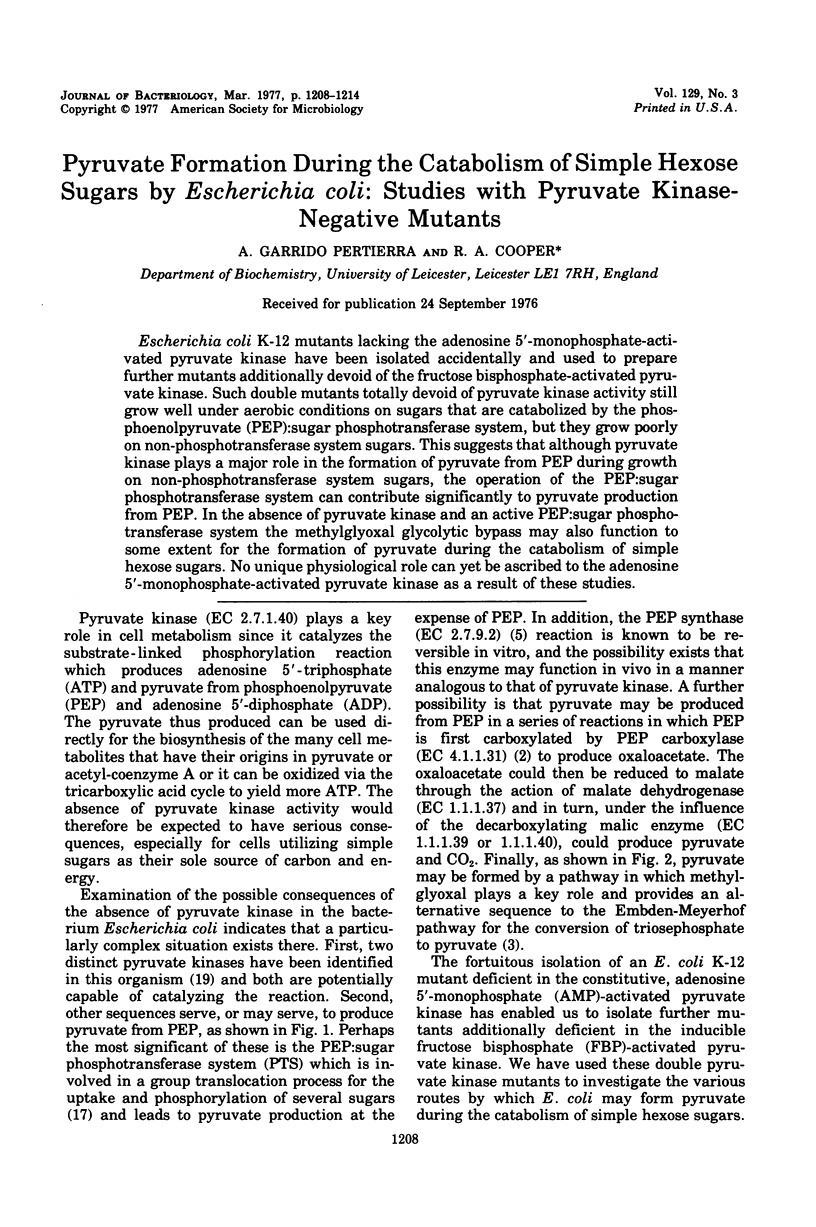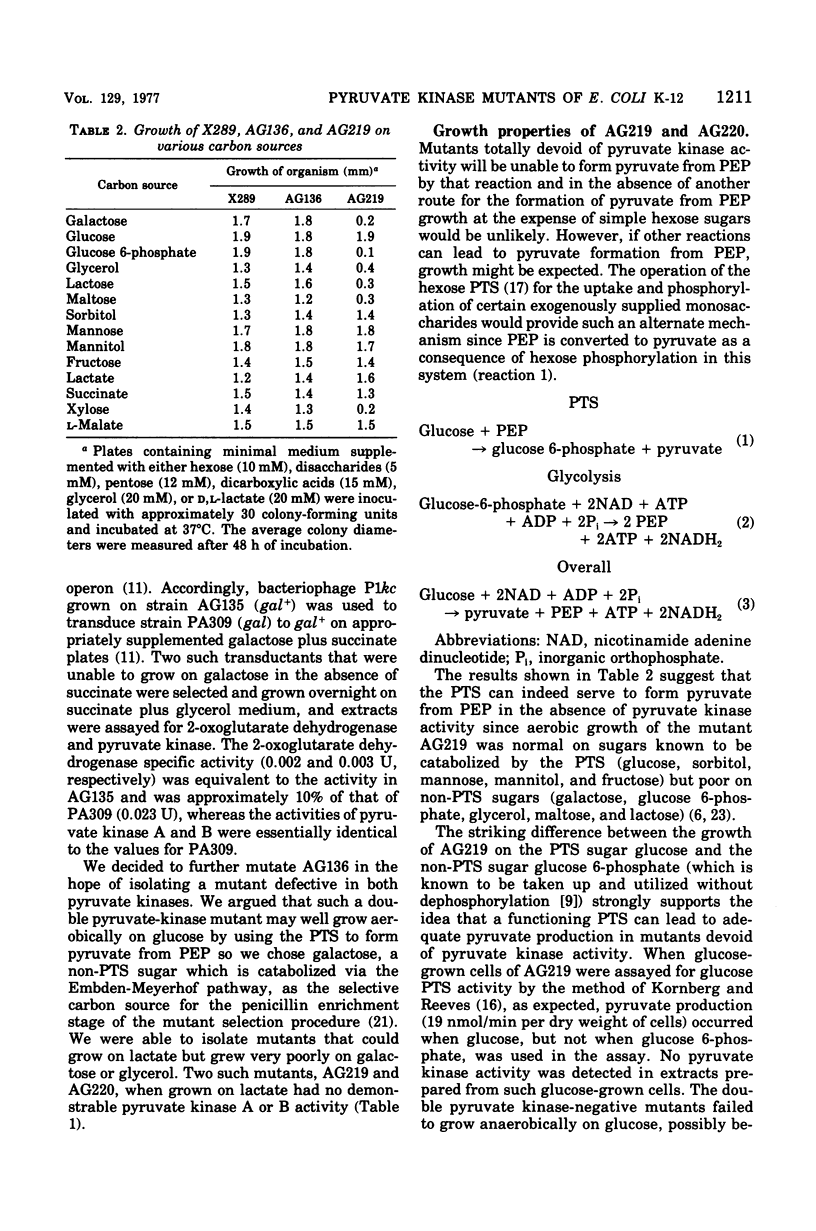Abstract
Escherichia coli K-12 mutants lacking the adenosine 5'-monophosphate-activated pyruvate kinase have been isolated accidentally and used to prepare further mutants additionally devoid of the fructose bisphosphate-activated pyruvate kinase. Such double mutants totally devoid of pyruvate kinase activity still grow well under aerobic conditions on sugars that are catabolized by the phosphoenolpyruvate (PEP):sugar phosphotransferase system, but they grow poorly on non-phosphotransferase system sugars. This suggests that although pyruvate kinase plays a major role in the formation of pyruvate from PEP during growth on non-phosphotransferase system sugars, the operation of the PEP:sugar phosphotransferase system can contribute significantly to pyruvate production from PEP. In the absence of pyruvate kinase and an active PEP:sugar phosphotransferase system the methylglyoxal glycolytic bypass may also function to some extent for the formation of pyruvate during the catabolism of simple hexose sugars. No unique physiological role can yet be ascribed to the adenosine 5'-monophosphate-activated pyruvate kinase as a result of these studies.
Full text
PDF






Selected References
These references are in PubMed. This may not be the complete list of references from this article.
- Anderson A., Cooper R. A. Genetic mapping of a locus for triosephosphate isomerase on the genome of Escherichia coli K12. J Gen Microbiol. 1970 Aug;62(3):329–334. doi: 10.1099/00221287-62-3-329. [DOI] [PubMed] [Google Scholar]
- Ashworth J. M., Kornberg H. L. The anaplerotic fixation of carbon dioxide by Escherichia coli. Proc R Soc Lond B Biol Sci. 1966 Aug 16;165(999):179–188. doi: 10.1098/rspb.1966.0063. [DOI] [PubMed] [Google Scholar]
- Cooper R. A., Anderson A. The formation and catabolism of methylglyoxal during glycolysis in Escherichia coli. FEBS Lett. 1970 Dec 11;11(4):273–276. doi: 10.1016/0014-5793(70)80546-4. [DOI] [PubMed] [Google Scholar]
- Cooper R. A., Kornberg H. L. The direct synthesis of phosphoenolpyruvate from pyruvate by Escherichia coli. Proc R Soc Lond B Biol Sci. 1967 Sep 12;168(1012):263–280. doi: 10.1098/rspb.1967.0065. [DOI] [PubMed] [Google Scholar]
- Curtis S. J., Epstein W. Phosphorylation of D-glucose in Escherichia coli mutants defective in glucosephosphotransferase, mannosephosphotransferase, and glucokinase. J Bacteriol. 1975 Jun;122(3):1189–1199. doi: 10.1128/jb.122.3.1189-1199.1975. [DOI] [PMC free article] [PubMed] [Google Scholar]
- Demerec M., Adelberg E. A., Clark A. J., Hartman P. E. A proposal for a uniform nomenclature in bacterial genetics. Genetics. 1966 Jul;54(1):61–76. doi: 10.1093/genetics/54.1.61. [DOI] [PMC free article] [PubMed] [Google Scholar]
- Doughty C. C., Hayashi J. A., Guenther H. L. Purification and properties of D-glycerate 3-kinase from Escherichia coli. J Biol Chem. 1966 Feb 10;241(3):568–572. [PubMed] [Google Scholar]
- FRAENKEL D. G., FALCOZ-KELLY F., HORECKER B. L. THE UTILIZATION OF GLUCOSE 6-PHOSPHATE BY GLUCOKINASELESS AND WILD-TYPE STRAINS OF ESCHERICHIA COLI. Proc Natl Acad Sci U S A. 1964 Nov;52:1207–1213. doi: 10.1073/pnas.52.5.1207. [DOI] [PMC free article] [PubMed] [Google Scholar]
- Hansen E. J., Juni E. Isolation of mutants of Escherichia coli lacking NAD- and NADP-linked malic. Biochem Biophys Res Commun. 1975 Jul 22;65(2):559–566. doi: 10.1016/s0006-291x(75)80183-5. [DOI] [PubMed] [Google Scholar]
- Herbert A. A., Guest J. R. Biochemical and genetic studies with lysine+methionine mutants of Escherichia coli: lipoic acid and alpha-ketoglutarate dehydrogenase-less mutants. J Gen Microbiol. 1968 Oct;53(3):363–381. doi: 10.1099/00221287-53-3-363. [DOI] [PubMed] [Google Scholar]
- Irani M., Maitra P. K. Isolation and characterization of Escherichia coli mutants defective in enzymes of glycolysis. Biochem Biophys Res Commun. 1974 Jan;56(1):127–133. doi: 10.1016/s0006-291x(74)80324-4. [DOI] [PubMed] [Google Scholar]
- KUNDIG W., GHOSH S., ROSEMAN S. PHOSPHATE BOUND TO HISTIDINE IN A PROTEIN AS AN INTERMEDIATE IN A NOVEL PHOSPHO-TRANSFERASE SYSTEM. Proc Natl Acad Sci U S A. 1964 Oct;52:1067–1074. doi: 10.1073/pnas.52.4.1067. [DOI] [PMC free article] [PubMed] [Google Scholar]
- Kaback H. R. The role of the phosphoenolpyruvate-phosphotransferase system in the transport of sugars by isolated membrane preparations of Escherichia coli. J Biol Chem. 1968 Jul 10;243(13):3711–3724. [PubMed] [Google Scholar]
- Katsuki H., Takeo K., Kameda K., Tanaka S. Existence of two malic enzymes in Escherichia coli. Biochem Biophys Res Commun. 1967 May 5;27(3):331–336. doi: 10.1016/s0006-291x(67)80102-5. [DOI] [PubMed] [Google Scholar]
- Kelker N. E., Anderson R. L. Evidence for vectorial phosphorylation of D-fructose by intact cells of Aerobacter aerogenes. J Bacteriol. 1972 Dec;112(3):1441–1443. doi: 10.1128/jb.112.3.1441-1443.1972. [DOI] [PMC free article] [PubMed] [Google Scholar]
- Kornberg H. L., Reeves R. E. Inducible phosphoenolpyruvate-dependent hexose phosphotransferase activities in Escherichia coli. Biochem J. 1972 Aug;128(5):1339–1344. doi: 10.1042/bj1281339. [DOI] [PMC free article] [PubMed] [Google Scholar]
- Malcovati M., Kornberg H. L. Two types of pyruvate kinase in Escherichia coli K12. Biochim Biophys Acta. 1969 Apr 22;178(2):420–423. doi: 10.1016/0005-2744(69)90417-3. [DOI] [PubMed] [Google Scholar]
- Malcovati M., Valentini G., Kornberg H. L. Two forms of pyruvate kinase in E. coli: their properties and regulation. Acta Vitaminol Enzymol. 1973;27(1):96–111. [PubMed] [Google Scholar]
- Roseman S. The bacterial phosphoenolpyruvate: sugar phosphotransferase system. Ciba Found Symp. 1975;(31):225–241. doi: 10.1002/9780470720134.ch13. [DOI] [PubMed] [Google Scholar]
- Waygood E. B., Rayman M. K., Sanwal B. D. The control of pyruvate kinases of Escherichia coli. II. Effectors and regulatory properties of the enzyme activated by ribose 5-phosphate. Can J Biochem. 1975 Apr;53(4):444–454. doi: 10.1139/o75-061. [DOI] [PubMed] [Google Scholar]
- Waygood E. B., Sanwal B. D. The control of pyruvate kinases of Escherichia coli. I. Physicochemical and regulatory properties of the enzyme activated by fructose 1,6-diphosphate. J Biol Chem. 1974 Jan 10;249(1):265–274. [PubMed] [Google Scholar]


